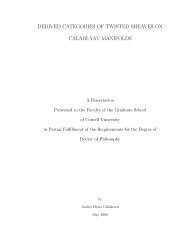FIVE MAJOR RESULTS IN ANALYSIS AND TOPOLOGY Aaron ...
FIVE MAJOR RESULTS IN ANALYSIS AND TOPOLOGY Aaron ...
FIVE MAJOR RESULTS IN ANALYSIS AND TOPOLOGY Aaron ...
You also want an ePaper? Increase the reach of your titles
YUMPU automatically turns print PDFs into web optimized ePapers that Google loves.
6. THE STONE- ˘ CECH COMPACTIFICATION 37<br />
Lemma (4). Every continuous map of X into a compact Hausdorff space Y extends<br />
uniquely to a continuous mapping of β(X) into Y .<br />
Proof. Since Y is completely regular, it can be imbedded in [0, 1] J for some J by<br />
Lemma 2, so we can assume that Y ⊂ [0, 1] J . Then each component function fα of f is a<br />
bounded continuous real function of X, so by Lemma 3, fα extends uniquely to a continuous<br />
map gα of β(X) into R. Let g : β(X) → R J be defined by g(x) = (gα(x)) α∈J . Then g<br />
is continuous because R J has the product topology, and from this continuity we note that<br />
g(β(X)) = g X ⊂ g(X) = f(X) ⊂ Y = Y , so that g maps β(X) into Y . <br />
Lemma 5 shows the uniqueness of the Stone- ˘ Cech compactification.<br />
Lemma (5). Any two compactification of X with property (1) are equivalent.<br />
Proof. Let β1(X) and β2(X) be two compactifications of X satisfying the extension<br />
property (1) of the Stone- ˘ Cech compactification. Let j2: X → β2(X) be the inclusion map.<br />
Since j2 is continuous, and because β1(X) has property (1), there is a unique continuous<br />
extension f2 of j1 to β1(X). Similarly, the inclusion map j1 : X → β1(X) has a unique<br />
continuous extension f1 defined on β2(X). Then f1 ◦ f2 maps β1 into itself and fixes X, so<br />
that f1 ◦ f2 is a continuous extension of iX, the identity map of X. Similarly, f2 ◦ f1 is a<br />
continuous extension of iX. By Lemma 4, f1 ◦ f2 = iβ1(X), and f2 ◦ f1 = iβ2(X), so that f1<br />
and f2 are homeomorphisms which fix X. <br />
Definition. Let X and Y be topological spaces. Then a surjective map f : X → Y is<br />
said to be a quotient map if a set U is open in Y if, and only if, f −1 (U) is open in X.<br />
Lemma. If X is Hausdorff and A is a compact subset of X, then A is closed.<br />
Proof. We will show that X − A is open. Given a point x ∈ X − A, choose, for each<br />
a ∈ A, disjoint open sets Ua and Va containing x and a, respectively. Since {Va} a∈A is an<br />
open cover of A, there is a finite subcollection of these open sets, say Va1,...,Van covering<br />
n<br />
A. Then U = is open, x ∈ U, and U ∩ A is empty. <br />
i=1<br />
Uai
















